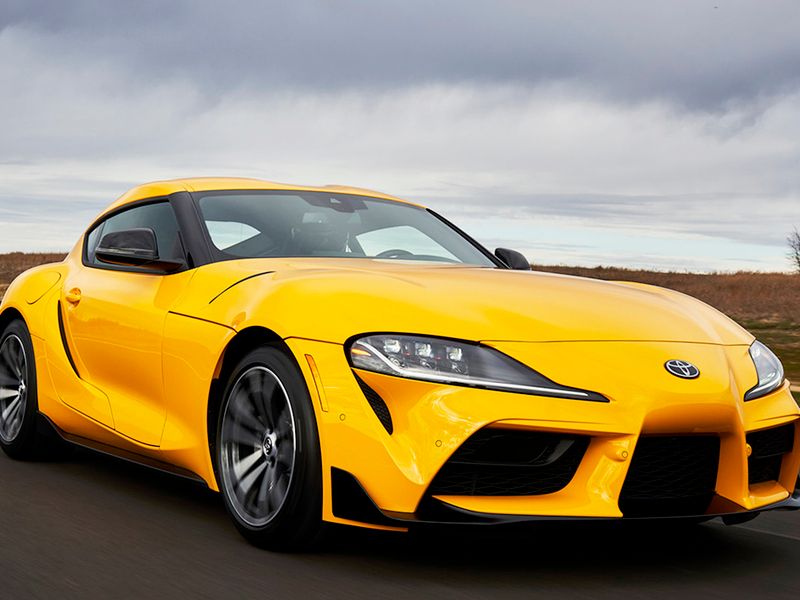
Just one model year after the Supra was revived, Toyota is adding a turbocharged 2.0-liter four-cylinder engine to the sports car’s lineup. The new entry-level Supra’s engine is rated at 255 hp, the model’s first turbo four. Toyota says the new engine reduces the car’s weight by nearly 200 pounds. The only gearbox available will be an eight-speed automatic. Here’s a roundup of select Supra four-cylinder reviews from the automotive media.
“Not only is there less weight, there is also less complexity. A sizeable chunk of the missing mass is chalked up to the removal of active hardware present on the 3.0 that is now mechanical on the 2.0. Compared to the six-cylinder, for example, the Supra 2.0 does away with the active suspension and active rear differential, though the electric power steering remains. According to Toyota, every aspect of the suspension and chassis is reworked compared to the more aggressive six-cylinder big brother.
“The result of this devolution is a much more approachable — and more friendly — driving experience. Performance certainly isn’t embarrassing; Toyota claims 0-60 mph takes 5.0 seconds against the Supra 3.0’s 3.9, but it shares the same 155-mph top speed. After a few hard on-ramp pulls, we’re convinced the figure feels closer to the middle-to-high four-second range. Recent instrumented tests prove Toyota (and project partner BMW) have a history of underrating the Supra (Z4), so color us nonplussed when those numbers start rolling in. Oh, not to mention: If that 5.0-second time stands, that’s a measly 0.1 second off of our sister publication Motor Trend‘s testing figures for the revered 1997 Toyota Supra Turbo. Just some food for thought.”
— Conner Golden, Automobile
“The Supra 2.0 has more of a comfort vibe versus the playful aggressiveness of the Supra 3.0. So much of the Supra’s appeal is in its bratty six-cylinder that snarls, pops and screams. The four-cylinder, while proficient and with respectable acceleration, doesn’t have the same mischievousness of the six or the turbo fours found in a Honda Civic Type R or Ford Focus RS. It also doesn’t have the eagerness in handling, exhibiting slower reactions and a bit more body roll. While I haven’t driven the Supra 2.0 on the track, I don’t think track duty would suit the entry-level car as well considering its more casual feel and downgraded brake calipers, rotors and lack of a limited-slip differential.”
— Joe Bruzek, Cars.com
“In the Supra, you get lots of low-end grunt, no real turbo lag to speak of and a hard charge up to redline. With just 3,181 pounds on the scales and nearly 300 lb-ft to play with, you have tons of grunt off the line and enough power to get yourself into legal trouble on the highway. Now, it’s not the mid-three-second 0-60 mph powerhouse the Supra 3.0 is, but I was genuinely pleased with its quickness and response. I had no trouble keeping up with Porsches, bigger-engined BMWs and several Subaru WRX STIs on a sunny afternoon drive on the Palisades Interstate Parkway, let’s just say that.
“It doesn’t have the manic, harsh, sing-for-your-supper character of the naturally aspirated flat-four in the 86, and indeed it’s much, much quicker. It just gets the job done with little drama and works well in something with a wheelbase this small. It’s actually got kind of a chill character to it as spirited as it is composed, but not nearly as hard-edged as many performance cars.”
— Patrick George, The Drive
“An eight-speed automatic is the only transmission offered, and it’s the same smooth-shifting ZF unit you’ll find in the Supra 3.0. It’s not a dual-clutch gearbox, but it’ll change gears just as quickly. Toyota fits the Supra with a pair of steering wheel-mounted paddles, too, but they’re not my jam. Besides, the transmission is nicely behaved on its own, and is happy to drop a gear or two when digging into the throttle.
“Because this engine is all about torque, it’s easy to keep the Supra running at low revs most of the time. There’s enough turbocharged twist to get this coupe out of its own way in a hurry, without having to rev the engine to high heaven. This makes the Supra easier to drive every day. It sounds nice in its lower and middle registers, too, and I can’t help but giggle every time I upshift and the exhaust lets out a cute little fart.”
— Steven Ewing, Roadshow by CNET
“The 2.0 would no doubt be a docile companion on a road course full of fast sweepers, but you’re not going to boot the tail out in slow corners for fun like you can with the 3.0. The standard eight-speed automatic transmission’s gearing is the same amongst all Supras, which is a little bit surprising.”
— Ezra Dyer, Car and Driver
“The peppy 2.0-liter engine and the eight-speed tranny still deliver a lively drive. Of course, the reduced power is notable, but the turbo-four is fun. Although the transmission upshifts quickly, it’s a tad slow to downshift. Sport mode will make the engine rev at higher rpms, and the transmission will hold gears longer and will act like it’s rev-matching on downshifts.
“One sad thing is that lifting off the throttle in Sport mode won’t trigger the raucous pops and crackles of the six-cylinder Supra; yes, they’re artificial, but they’re cool. Toyota should also consider installing more sound deadening materials, as the interior gets a lot of road noise.”
— Miguel Cortina, Motor Trend